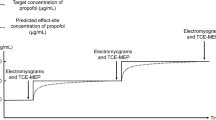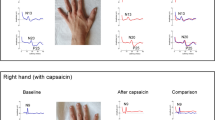Abstract
Somatosensory evoked potentials (SEPs) have been linked to noxious activation and stimulus intensity. In this exploratory study we investigated the impact of anaesthetic drugs on SEPs and pain ratings, to assess their applicability as an objective measure of the nociception/anti-nociception balance. Following institutional approval and written informed consent, 10 healthy adult volunteers were enrolled (29.5 ± 9.1 years, 63.0 ± 8.9 kg and 171.4 ± 7.2). Median nerve electrical stimulation was adjusted according to volunteers’ sensitive, motor and painful thresholds (PT). Baseline SEPs were registered, and remifentanil and propofol administered using a stair scheme TCI. For each drug combination a 1.3×PT stimulus was administered, and volunteers evaluated pain intensity in a numerical rating scale (0–10). SEPs’ amplitudes and latencies were normalized by the baseline values, reducing volunteers’ intervariability. Stimulation currents varied between 6–52 mA (1.3×PT) and pain ratings between 0 and 9. Cortical SEPs latencies were decreased for higher stimulus intensities (P < 0.01), accompanied by increased pain ratings (P < 0.01). An individually adjusted/normalized ratio based on cortical SEPs amplitude and interpeak latency is proposed(\(R_{Norm}\)): \(R_{Norm}\) and NSR were significantly correlated in three out of nine subjects, and \(R_{Norm}\) and remifentanil Ce were significantly correlated in two (low number of evaluation points). \(R_{Norm}\) was shown to decrease with increasing doses of propofol and remifentanil (P < 0.05). The proposed metric was depressed by anaesthetics and reflected pain evaluations. Further research is necessary to increase the number of volunteers and drugs’ combination, to assess its applicability during surgically adequate anesthetic leves.




Similar content being viewed by others
References
Arendt-Nielsen L, Bjerring P. Reaction times to painless and painful CO2 and argon laser stimulation. Eur J Appl Physiol. 1988a;58(3):266–73.
Arendt-Nielsen L, Bjerring P. Sensory and pain threshold characteristics to laser stimuli. J Neurol Neurosurg Psychiatry. 1988b;51(1):35–42.
Barvais L, Engelman E, Eba JM, Coussaert E, Cantraine F, Kenny GN. Effect site concentrations of remifentanil and pupil response to noxious stimulation. Br J Anaesth. 2003;91(3):347–52.
Bonhomme V, Llabres V, Dewandre PY, Brichant JF, Hans P. Combined use of bispectral indextm and a-linetm autorregressive indextm to assess anti-nociceptive component of balanced anaesthesia during lumbar arthodesis. Br J Anaesth. 2006;96(3):353–60.
Borgeat A, Wilder-Smith OH, Suter PM. The nonhypnotic therapeutic applications of propofol. Anesthesiology. 1994;80(3):642–56.
Bornhövd K, Quante M, Glauche V, Bromm B, Weiller C, Bchel C. Painful stimuli evoke different stimulus-response functions in the amygdala, prefrontal, insula and somatosensory cortex: a single-trial fmri study. Brain. 2002;125(6):1326–36.
Brunton L, Parker K, Blumenthal D, Buxton I (eds). Goodman and gilman’s manual of pharmacology and therapeutics, 12th edn. McGraw Hill; 2008.
Chernik DA, Gillings D, Laine H, Hendler J, Silver JM, Davidson AB, Schwam EM, Siegel JL. Validity and reliability of the observer’s: Assessment of alertness/sedation scale: Study with intravenous midazolam. J Clin Psychopharmacol. 1990;10(4).
Crabb I, Thornton C, Konieczko KM, Chan A, Aquilina R, Frazer N, Dor CJ, Newton DE. Remifentanil reduces auditory and somatosensory evoked responses during isoflurane anaesthesia in a dose-dependent manner. Br J Anaesth. 1996;76(6):795–801.
Fu ES, Zhang Y, Li Q, Morris RW, Levitt RC. Baseline differences in mechanical nociception: Genetic regulation. Anesthesiology p A505; 2010.
Gannong WF (ed). Review of Medical Physiology, 22nd edn. Lange Medical Books/McGraw-Hill; 2005.
Greenwald SD, Rosow C. Bis and emg variability increase before somatic responses during surgery. Anesthesiology. 2006;105:1027.
Gruenewald M, Meybohm P, Ilies C, Hcker J, Hanss R, Scholz J, Bein B. Influence of different remifentanil concentrations on the performance of the surgical stress index to detect a standardized painful stimulus during sevoflurane anaesthesia. Br J Anaesth. 2009;103(4):586–93.
Kruger L (ed). Methods in pain research. CRC Press; 2001.
Kumar A, Bhattacharya A, Makhija N. Evoked potential monitoring in anaesthesia and analgesia. Anaesthesia. 2000;55(3):225–41.
ller EAM, Spangsberg N, Arendt-Nielsen L, Schultz P, Kristensen MS, Bjerring P. Subhypnotic doses of thiopentone and propofol cause analgesia to experimentally induced acute pain. Br J Anaesth. 1991;66(2):185–8.
Mashour GA. Neurophysiology and intraoperative nociception: new potentials? Anesthesiology. 2013;118:239–40.
Melzack R, Torgerson WS. On the language of pain. Anesthesiology. 1971;34(1):50–9.
Miltner W, Jr, RJ, Braun C, Larbig W, Somatosensory event-related potentials to painful and non-painful stimuli: effects of attention. Pain. 1989;38(3):303–12.
Minto CF, Schnider TW, Shafer SL. Pharmacokinetics and pharmacodynamics of remifentanil. ii. model application. Anesthesiology. 1997;86:24–33.
Ohara S, Crone NE, Weiss N, Treede RD, Lenz FA. Amplitudes of laser evoked potential recorded from primary somatosensory, parasylvian and medial frontal cortex are graded with stimulus intensity. Pain. 2004;110(1–2):318–28.
Rantanen M, Yli-Hankala A, Gils MV, Yppril-Wolters H, Takala P, Huiku M, Kymlinen M, Seitsonen E, Korhonen I. Novel multiparameter approach for measurement of nociception at skin incision during general anaesthesia. Br J Anaesth. 2006;96(3):367–76.
Rhoades RA, Bell DR (eds). Medical physiology principles for clinical medicine, 3rd edn. Lippincott Williams and Wilkins, 2009.
Schnider TW, Minto CF, Gambus PL, Andresen C, Goodale DB, Shafer SL, Youngs EJ. The influence of method of administration and covariates on the pharmacokinetics of propofol in adult volunteers. Anesthesiology. 1998;88:1170–82.
Shaw FZ, Chen RF, Tsao HW, Yen CT. Comparison of touch- and laser heat-evoked cortical field potentials in conscious rats. Brain Res. 1999;824(2):183–96.
Storm H. Changes in skin conductance as a tool to monitor nociceptive simulation and pain. Curr Opin Anaesthesiol. 2008;21(6):796–804.
Thornton C, Sharpe RM. Evoked responses in anaesthesia. Br J Anaesth. 1998;81(5):771–81.
Thornton C, Creagh-Barry P, Jordan C, Luff NP, Dor CJ, Henley M, Newton DE. Somatosensory and auditory evoked responses recorded simultaneously: differential effects of nitrous oxide and isoflurane. Br J Anaesth. 1992;68(5):508–14.
Untergehrer G, Jordan D, Eyl S, Schneider G. Effects of propofol, sevoflurane, remifentanil, and (s)-ketamine in subanesthetic concentrations on visceral and somatosensory painevoked potentials. Anesthesiology. 2013;118:308–17.
Acknowledgments
The authors would like to thank the participation of all volunteers and clinical investigators in this study, especially Dr. Francisco Lobo, Dr. Liliana Pinto, Dr. Diana Afonso, Dr. Germano Cardoso, Dr. Helena and Dr. Luís Silva (Neurinbloc). The first author was supported by a scholarship from the Portuguese Foundation for Science and Technology (FCT - SFRH/BD/35879/2007). The authors would also like to acknowledge the UISPA-IDMEC Porto.
Conflict of interest
The authors declare that they have no conflict of interest.
Author information
Authors and Affiliations
Corresponding author
Rights and permissions
About this article
Cite this article
Castro, A., Amorim, P., Nunes, C.S. et al. Effect of propofol and remifentanil on a somatosensory evoked potential indicator of pain perception intensity in volunteers. J Clin Monit Comput 29, 561–567 (2015). https://doi.org/10.1007/s10877-014-9632-0
Received:
Accepted:
Published:
Issue Date:
DOI: https://doi.org/10.1007/s10877-014-9632-0




